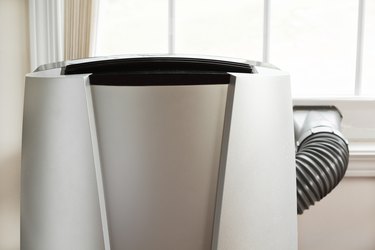
Trying to figure out how to run a portable air conditioner without hoses? While you can get away with not having a water hose, you'll still need an exhaust hose to run a portable air conditioner in your home. You can work around the inconvenience of having the exhaust hose or try an alternative cooling method.
How Portable Air Conditioners Work
Video of the Day
Like dehumidifiers, air conditioners pull water out of damp air. Thanks to advances in technology, portable air conditioners minimize the amount of waste water they create. Units now encourage the evaporation of most of the water they collect and gather the rest in a removable reservoir that you must periodically empty.
Video of the Day
This eliminates the need to run water hoses through the room, but exhaust hoses are still critical components of portable air conditioners. Unfortunately, there is no way to run a portable air conditioner without an exhaust hose. You can buy a ventless air cooler to make a room more comfortable, but these units are not truly air conditioners.
True Air Conditioners
Like all air conditioners, portable units work by pulling in warm air and running it through a cooling system filled with refrigerant. Instead of making the air cold, refrigerant absorbs the heat from it. This heat has to go somewhere, and so is vented outside.
Venting the hot air inside would prevent the room from cooling down. Once you understand how the air conditioner works, it's easy to see why every portable air conditioner needs a vent hose run to the outside of the building. There is simply no way to get around it.
Dealing With Hoses
To minimize the inconvenience of your portable AC's vent hose, set your air conditioner as close to your window as you can. The closer the unit is to the widow, the shorter the vent hose you'll need to deal with. If you can't get your unit close to the window and fear that someone may trip over the vent hose, it is possible to run the hose through a ceiling or wall and to the outside. These venting options also work in windowless rooms.
Venting your portable air conditioner through a wall requires cutting a hole through the wall. Doing so is an effective way to vent the air conditioner, but may make the unit considerably less portable. Plan a way to close any ventilation holes you make when winter comes, before you start cutting.
Ventless Air Conditioners
To avoid the hassle of hoses, some retailers sell ventless air conditioners. Also known as swamp coolers or evaporative coolers, these devices aren't actually air conditioners at all. While an air conditioner water tank needs emptying to eliminate the water the unit pulls from the air, the water tank in an evaporative cooler must be filled in order to work. The water in the tank is pumped into a membrane, and then a fan forces air through that membrane.
As the air passes through the wet membrane, the water evaporates, removing heat as it does so. As a result, the air that comes out of the evaporator is cooler than the air going in. This is the same principle as perspiration. As air moves across your skin and your sweat evaporates, your body feels cooler.
Evaporative coolers require no vent or water hoses and are completely self-contained, making them a good choice for those who need portable cooling without hoses. However, evaporative coolers work best in areas of low humidity. A humidity level of 60 percent or higher will render an evaporative cooler much less effective. In less humid climates, evaporative coolers can be just as effective as portable air conditioners while using less energy.